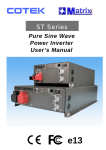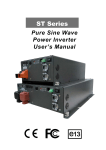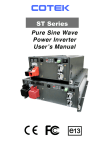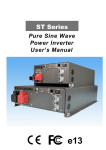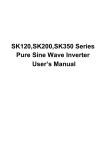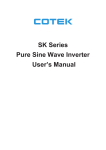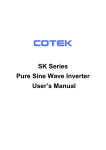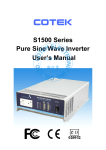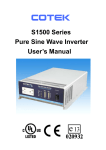Download Cotek S300 Series User`s manual
Transcript
S150,S300 Series Pure Sine Wave Inverter User’s Manual List of contents 1. Important Safety Instructions……………………………………………… 3 1-1 General Safety Precautions…………………………………………… 3 1-2 Precautions When Working With Batteries………………………….. 3 2. Features………………………………………………………………………... 4 2-1 Electrical Performance 150W….……………………………………… 4 2-2 Electrical Performance 300W….……………………………………… 5 2-3 Mechanical Drawings 150W.………………………………………….. 6 2-4 Mechanical Drawings 300W.………………………………………….. 7 3. Introduction…………………………………………………………………… 8 3-1 Front Panel Operations………………………………………………... 8 3-2 Rear Panel Operations………………………………………………… 8 3-3 AC Safety Grounding…………..………………………………………. 9 3-4 Installation………………………..……………………………………... 10 3-5 DC Input (Outlet sockets available)……….………………………….. 11 3-6 AC output (Outlet sockets available)…………………………………. 11 4. Troubleshooting guide……………………………………………………… 12 5. Maintenance…………………………………………………………………… 13 6. Warranty……………………………………………………………………….. 13 2 1. Important Safety Instructions WARNING! Before you install and use Your Inverter, to read and save these safety instructions. 1-1. General Safety Precautions 1-1-1. Do not expose the Inverter to rain, snow, spray, bilge or dust. To reduce risk of hazard, do not obstruct the ventilation openings. Do not install the Inverter in a zero-clearance compartment. Overheating may result. 1-1-2. To avoid a risk of fire and electric shock. Make sure that existing wiring is in good electrical conditions and the size is not undersized. Do not operate the Inverter with damaged or substandard wiring. 1-1-3. This equipment contains components which can produce arcs or sparks. To prevent fire or explosion, do not install in compartments containing batteries or Flammable materials or in locations which require ignition protected equipment. This includes any space containing gasoline-powered machinery, fuel tanks, or joints, fittings, or other connection between components of the fuel system. 1-2. Precautions When Working with Batteries 1-2-1. If battery acid contacts skin or clothing, wash immediately with soap and water. If acid enters eye, immediately flood eye with running cold water for at least 20 minutes and get medical attention immediately. 1-2-2. Never smoke or allow a spark or flame in vicinity of battery or Engine. 1-2-3. Do not drop a metal tool on the battery. The resulting spark or short-circuit on the battery of other electrical part may cause an explosion. 1-2-4. Remove personal metal items such as rings, bracelets, necklaces, and watches when working with a lead-acid battery. A lead-acid battery can produces a short-circuit current high enough to weld a ring or the like to metal, causing severe burns. 3 2.Features 2-1. Electrical Performance 150W Specification Item Model No. S150-112 S150-124 Continuous Output Power 150W Surge Rating 200W S150-212 S150-224 Input Voltage 12V 24V 12V 24V Input Voltage Range 10.5 – 15.0 21.0 – 30.0 10.5 – 15.0 21.0 – 30.0 Output Voltage 110 VAC ±5% Frequency 230 VAC ±5% 50 / 60Hz ± 0.3% Max. Efficiency 87% 88% 87% 88% No Load Current Draw 0.20A 0.16A 0.22A 0.16A Output Waveform Pure Sine Wave ( THD 5.0% Typical ) Power Factor Allowed cosθ-90° ~ cosθ+90° Protection Remote Control Overload, Short Circuit, Reverse Polarity (Fuse), Over / Under Input Voltage, Over Temperature. Yes, On/Off controlled by external switch Safety UL458 EMC FCC Class B EN60950 EN55022:1997 EN61000-3-2:1998 e-Mark EN61000-3-3:1995 e13-022025 EN55024:2001 Operating Temperature 0 – 40 ℃ Storage Temperature -30℃ to 70℃ Fan Cooling Thermostatically controlled Dimensions (L x W x H) 200 x 132 x 72 mm / 7.87 x 5.20 x 2.83 inch Weight 2.7 kgs. / 5.4 Lbs. 4 2-2. Electrical Performance 300W Specification Item Model No. S300-112 S300-124 Continuous Output Power 300W Surge Rating 400W S300-212 S300-224 Input Voltage 12V 24V 12V 24V Input Voltage Range 10.5 – 15.0 21.0 – 30.0 10.5 – 15.0 21.0 – 30.0 Output Voltage 110 VAC ±5% Frequency 230 VAC ±5% 50 / 60Hz ± 0.3% Max. Efficiency 89% 89% 89% 89% No Load Current Draw 0.24A 0.28A 0.26A 0.28A Output Waveform Pure Sine Wave ( THD 5% Typical ) Power Factor Allowed cosθ-90° ~ cosθ+90° Protection Remote Control Overload, Short Circuit, Reverse Polarity (Fuse), Over / Under Input Voltage, Over Temperature. Yes, On/Off controlled by external switch Safety UL458 EMC FCC Class B EN60950 EN55022:1997 e-Mark EN61000-3-2:1998 e13-022078 EN61000-3-3:1995 EN55024:2001 Operating Temperature 0 – 40 ℃ Storage Temperature -30℃ to 70℃ Fan Cooling Thermostatically controlled Dimensions (L x W x H) 237 x 155 x 72 mm / 9.33 x 6.10 x 2.83 inch Weight 3.5 kgs. / 7.7 Lbs. 5 2-3. Mechanical Drawing 150W CHASSIS GROUND DC INPUT PURE SINE WAVE INVERTER 150W ON I 0 REMOTE AC OFF REMO. OUTPUT POWER STATUS PORT 6 2-4. Mechanical Drawing 300W REVERSE POLARITY WILL DAMAGE UNIT WARNING: CHASSIS GROUND POS+ NEG - DC INPUT PURE SINE WAVE INVERTER 300W ON I 0 OFF REMO. AC OUTPUT POWER STATUS REMOTE PORT 7 3. Introduction This series models are the most, reliable, multi protections, compact size, pure sine wave inverters that used in wide range of applications including Mobile, Office equipments, Home entertainments, electronics hold equipments. To get the most out of the power inverter, it must be installed and used properly. Please read the instructions in this manual before installation and operation this model. 3-1. Front Panel Operations: 3-1-1. ON / OFF/ REMOTE switch: Leave the Power ON / OFF / REMOTE switch in the OFF position during installation. 3-1-2 LED display indicates Power Status LED Conditions Status Solid Green AC Power OK Blinked Red fast OVP Blinked Red slowly UVP Blinked Red intermittently OTP Solid Red OLP 3-1-3. Remote Port: Placing 0.75mm2 and Screw type cable between remote port and panel. 3-2. Rear Panel Operations 3-2-1. Ventilation window: Do not obstruct, allow at least 3 inch of clearance for airflow. 3-2-2. Input terminals: Connect 12V / 24V batteries or other 12V / 24V power sources. 【+】is positive,【-】is negative. Reverse polarity connection will blow internal fuse and may damage inverter permanently. 3-2-3. Using # 8 AWG wire to connects Chassis ground with Vehicle Chassis. 8 WARNING! Do not connect the 12V model to a 24V battery, the unit will be destroyed immediately. Operation of the inverter without a proper ground connection may result an electrical safety hazard. Damage caused by reversed polarity is not covered by the warranty. Make sure the power switch is in the OFF position before connecting the battery. 3-3. AC Safety Grounding: During the AC wiring installation, AC input and output ground wires are connected to the inverter. The AC input ground wire must connect to the incoming ground of your AC utility source. The AC output ground wire should go to the grounding point for your loads ( for example, a distribution panel ground bus ). 3-3-1. Neutral Grounding (GFCI’S): 110V models:The neutral conductor of the AC output circuit of the Inverter is automatically connected to the safety ground during inverter operation. This conforms to National Electrical Code requirements that separately derived AC sources (such as inverter and generators) have their neutral conductors tied to ground in the same way that the neutral conductor from the utility is tied to ground at the AC breaker panel. For models configured with a transfer relay, while AC utility power is presenting and the Inverter is in bypass mode, this connection (neutral of the Inverter’s AC output to input safety ground) is not present so that the utility neutral is only connected to ground at your breaker panel, as required. Cotek has tested the following GFCI – protected 20A receptacles and found that they functioned properly when connected to the output of the Inverter 9 WARNING! Never connect the inverter’ output to the AC distribution grid, such as your household AC wall outlet. It will damage the Inverter. 3-4. Installation Before connect your applications to the inverter, always check the power draw of your appliances. The inverter is affordable to supply surge power for a short time so as to start up the electrical equipments such as motor, pumps… that need more power while starting up. When all the above requirements are checked OK and satisfied and all connections are made, it’s the time to turn on your inverter by pushing the power switch to the ‘ I ’ position. The sine wave shaped output voltage gently rises from AC outlet. When the inverter is not supplying power to an application for a longer time, it’s recommended to turn off the inverter to save your batteries since it still draws a small amount of current in the “ no load ” condition. DC input voltage status as follows: Model DC Input Over Voltage DC Input Under Voltage Shut-down Restart Shut-down Restart 12V models 15.3 14.8 10.5 12.5 24V models 30.6 29.6 21.0 25.0 10 3-5. DC Input (Outlet sockets available): CIGARET CLAMP TERMINAL 3-6. AC output (Outlet sockets available): North America (GFCI) North America (NEMA 5-15R) Continental European (SCHUKO) Australia / New Zealand United Kingdom Universal IEC-1 IEC-2 11 4. Troubleshooting guide: WARNING! Do not open or disassemble the Inverter. Attempting to service the unit yourself may result in a risk of electrical shock or fire. Problems and Symptoms Possible Cause No output voltage, the LED glows RED light. Solutions a. Power status light is blinked red fast. b. Power status light is blinked red slowly. Over input voltage. Check input voltage. Reduce input voltage. Recharge battery. Check connections and cable. c. Power status light is blinked red Intermittently. Thermal shutdown Improve ventilation. Make sure ventilation openings in inverter are not obstructed. Reduce ambient temperature. d. Power status light is glowed red steadily. Short circuit, Wiring error, Over Load Check AC wiring for short circuit. Remove load. Low input voltage. 12 5. Maintenance: Very little maintenance is required to keep your inverter operating properly. You should clean the exterior of the unit periodically with a damp cloth to prevent accumulation of dust and dirt. At the same time, tighten the screws on the DC input terminals. 6. Warranty: We warrant this product against defects in materials and workmanship for a period of 24 months from the date of purchase and will repair or replace any defective Power Inverter when directly returned, postage paid, to us. This warranty will be considered void if the unit has suffered any obvious physical damage or alteration either internally or externally and does not cover damage arising from improper use such as plugging. The unit into an unsuitable power sources attempts to operate products with excessive power consumption requirements, or use in unsuitable environments. This is the only warranty that the company makes. No other warranties express or imply including warranties of merchantability and fitness for a particular purpose. Repair and replacement are your sole remedies and the company shall not be liable for damages, whether direct, incidental, special or consequential, even though caused by negligence or other fault. 13













